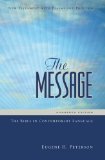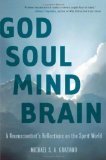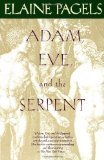Lee Harmon's Blog, page 120
August 13, 2011
Acts 1:18-19, The Many Stories of Judas
With the reward he got for his wickedness, Judas bought a field; there he fell headlong, his body burst open and all his intestines spilled out. Everyone in Jerusalem heard about this, so they called that field in their language Akeldama, that is, Field of Blood.
//Bible writers often seem to take liberty with facts, relaying a story more for its meaning than for its historical accuracy. This often leads to what we consider contradictions in the Bible, because we have such a habit of reading the Bible literally. But this expectation of historical accuracy is unfair to the flavor of the Bible. Nowhere is this more obvious than in the tale of Judas, where we have two completely different stories, but with a similar portrayal and moral, ending in a possible factoid … a Field of Blood.
Let's begin with Luke's tale, as it seems just a bit more plausible. As in Mark and John, here Judas receives an untold amount of money for betraying Jesus. Afterward, Judas purchases a field with the money, but divine justice catches up with him. He falls in the field, spilling his guts (quite literally), so they name it the Field of Blood.
Matthew tells an entirely different story. In Matthew's version, Judas receives exactly thirty pieces of silver for betraying Jesus, which is clearly meant to bring to mind the story of the rejected shepherd in Zechariah. (Matthew mistakenly attributes the "prophecy" of thirty pieces of silver to Jeremiah, but it was Zechariah.) Lets look at that story now, to see where Matthew is going with this line of thought.
Zechariah 11:12-13, I told them, "If you think it best, give me my pay; but if not, keep it." So they paid me thirty pieces of silver. And the LORD said to me, "Throw it to the potter"--the handsome price at which they priced me! So I took the thirty pieces of silver and threw them into the house of the LORD to the potter.
Zechariah's shepherd takes the money and throws it into the temple, the "house of the LORD." So, Matthew revises his story of Judas. Please don't ask why Judas is playing the "shepherd" role instead of the bad guy; I don't know. But Judas no longer purchases a field with his money. Filled with regret, he brings the money back to chief priests—exactly thirty pieces of silver, of course—and throws it down in the temple.
In Mark's Gospel, the story of Judas provides a literary reference to 2 Samuel, where Ahithophel is the betrayer of David … just as Judas betrayed Jesus. In that story, Ahithophel hanged himself, and so Matthew reports the same end for Judas.
But that presents a problem for Matthew. How, then, to account for the field of blood? Matthew finds another solution; in his version, the returned money is used by the chief priests to buy the "Potters Field" because it is "blood money." Thus the field comes to be known as the Field of Blood.
//Bible writers often seem to take liberty with facts, relaying a story more for its meaning than for its historical accuracy. This often leads to what we consider contradictions in the Bible, because we have such a habit of reading the Bible literally. But this expectation of historical accuracy is unfair to the flavor of the Bible. Nowhere is this more obvious than in the tale of Judas, where we have two completely different stories, but with a similar portrayal and moral, ending in a possible factoid … a Field of Blood.
Let's begin with Luke's tale, as it seems just a bit more plausible. As in Mark and John, here Judas receives an untold amount of money for betraying Jesus. Afterward, Judas purchases a field with the money, but divine justice catches up with him. He falls in the field, spilling his guts (quite literally), so they name it the Field of Blood.
Matthew tells an entirely different story. In Matthew's version, Judas receives exactly thirty pieces of silver for betraying Jesus, which is clearly meant to bring to mind the story of the rejected shepherd in Zechariah. (Matthew mistakenly attributes the "prophecy" of thirty pieces of silver to Jeremiah, but it was Zechariah.) Lets look at that story now, to see where Matthew is going with this line of thought.
Zechariah 11:12-13, I told them, "If you think it best, give me my pay; but if not, keep it." So they paid me thirty pieces of silver. And the LORD said to me, "Throw it to the potter"--the handsome price at which they priced me! So I took the thirty pieces of silver and threw them into the house of the LORD to the potter.
Zechariah's shepherd takes the money and throws it into the temple, the "house of the LORD." So, Matthew revises his story of Judas. Please don't ask why Judas is playing the "shepherd" role instead of the bad guy; I don't know. But Judas no longer purchases a field with his money. Filled with regret, he brings the money back to chief priests—exactly thirty pieces of silver, of course—and throws it down in the temple.
In Mark's Gospel, the story of Judas provides a literary reference to 2 Samuel, where Ahithophel is the betrayer of David … just as Judas betrayed Jesus. In that story, Ahithophel hanged himself, and so Matthew reports the same end for Judas.
But that presents a problem for Matthew. How, then, to account for the field of blood? Matthew finds another solution; in his version, the returned money is used by the chief priests to buy the "Potters Field" because it is "blood money." Thus the field comes to be known as the Field of Blood.
Published on August 13, 2011 07:30
August 12, 2011
Book review: the Feasts of the Lord
 by Kevin Howard and Marvin Rosenthal
by Kevin Howard and Marvin Rosenthal ★★★★★
Excellent! Whether you are a Jesus scholar or a Christian, this book is for you. And if you're both, this book can't be missed. You'll learn about:
PassoverThe Feast of Unleavened BreadThe Feast of FirstfruitsShavuot – The Feast of WeeksRosh Hashanah – The Feast of TrumpetsYom Kippur – The Day of AtonementSukkot – The Feast of TabernaclesHanukkah – The Feast of DedicationPurim – the Feast of Lots
Also there's a great discussion of the Jubilee year. Inspirational and informative, complete with pictures, photos and charts, Howard and Rosenthal first explain the Jewish calendar and discuss the flavor and atmosphere of the Spring and Fall seasons. Then they go through each of the feasts in more detail, presenting their Biblical observance, modern-day observance among Jews, and most fascinating of all, their fulfillment by Jesus. Preterists and historical-critical scholars will easily relate the fulfillment of each feast to the first century, while believers in a futuristic return of Christ will be just as satisfied. (Howard and Rosenthal subscribe to the traditional futuristic interpretation.)
I can't overemphasize how much more meaning you'll find when you read Paul and the Gospels if you start with a basic understanding of the Jewish Feasts. The New Testament just reads so much more rich and inspirational from a Jewish perspective! Particularly the Johannine literature, John's Gospel and Revelation, in which an underlying theme is the fulfillment of the Jewish Feasts. Both these Biblical books recognize the destruction of the Temple as the end of an age, presenting Jesus as the replacement for all the Jewish rituals.
(click picture to buy on Amazon)
Published on August 12, 2011 07:00
August 11, 2011
Revelation 8:11, Wormwood
[T]he name of the star is Wormwood. A third of the waters turned bitter, and many people died from the waters that had become bitter.
//In Revelation, seven trumpets blare in turn, initiating multiple horrors upon the earth. This verse stems from the third trumpet, which foretells a great star, burning like a torch, falling from the sky. John of Patmos names this star "Wormwood."
Wormwood is a bitter plant. John gave this blazing star (or perhaps just a particularly large fireball--many have related the imagery of this chapter to the eruption of Vesuvius in 79 A.D.) the name "Bitterness." It may be a reference to the polluted waters from the falling ash. Deuteronomy uses the term "Wormwood" to warn Israel of their destruction if they become disobedient. If this chapter in Revelation truly refers to the volcanic eruption of Vesuvius, then John connects the pestilence caused by its spreading ash to the covenantal punishment described in the books of Moses.
The next trumpet to sound marks a third of the sun being struck, and a third of the day going dark, an eerily precise description of the ashen haze when Vesuvius erupted, as reported by Pliny the Younger: "The sun was blocked out by the eruption and the daylight hours were left in darkness." Ash from the eruption reached Africa, Syria, and Egypt, causing pestilence. John's name for the fireball he describes, Wormwood, is perfect.
//In Revelation, seven trumpets blare in turn, initiating multiple horrors upon the earth. This verse stems from the third trumpet, which foretells a great star, burning like a torch, falling from the sky. John of Patmos names this star "Wormwood."
Wormwood is a bitter plant. John gave this blazing star (or perhaps just a particularly large fireball--many have related the imagery of this chapter to the eruption of Vesuvius in 79 A.D.) the name "Bitterness." It may be a reference to the polluted waters from the falling ash. Deuteronomy uses the term "Wormwood" to warn Israel of their destruction if they become disobedient. If this chapter in Revelation truly refers to the volcanic eruption of Vesuvius, then John connects the pestilence caused by its spreading ash to the covenantal punishment described in the books of Moses.
The next trumpet to sound marks a third of the sun being struck, and a third of the day going dark, an eerily precise description of the ashen haze when Vesuvius erupted, as reported by Pliny the Younger: "The sun was blocked out by the eruption and the daylight hours were left in darkness." Ash from the eruption reached Africa, Syria, and Egypt, causing pestilence. John's name for the fireball he describes, Wormwood, is perfect.
Published on August 11, 2011 06:26
August 10, 2011
Book review: The Message Bible
 by Eugene H. Peterson
by Eugene H. Peterson
★★★★
I love this contemporary Bible! It's not the most accurate translation—it's really not fair to even call it a translation, but rather a paraphrase betraying Peterson's religious convictions—but I just find it enjoyable to read. It's poetic and beautiful. Do not use it as a study Bible, but as an inspiring read.
I chose the book of John to highlight some of the translations, so you can get a feel for the wording. These aren't my favorite passages, but they do highlight what I mean by a "paraphrasing."
KJV: John 1:12-13, But as many as received him, to them gave he power to become the sons of God, even to them that believe on his name: Which were born, not of blood, nor of the will of the flesh, nor of the will of man, but of God.
Message: But whoever did want him, who believed he was who he claimed and would do what he said, He made to be their true selves, their child-of-God selves. These are the God-begotten, not blood-begotten, not flesh-begotten, not sex-begotten.
KJV: John 1:31, And I knew him not: but that he should be made manifest to Israel, therefore am I come baptizing with water.
Message: I knew nothing about who he was—only this: that my task has been to get Israel ready to recognize him as the God-Revealer. That is why I came here baptizing with water, giving you a good bath and scrubbing sins from your life so you can get a fresh start with God.
KJV: John 3:29-30, He that hath the bride is the bridegroom: but the friend of the bridegroom, which standeth and heareth him, rejoiceth greatly because of the bridegroom's voice: this my joy therefore is fulfilled. He must increase, but I must decrease.
Message: The one who gets the bride is, by definition, the bridegroom. And the bridegroom's friend, his 'best man'—that's me—in place at his side where he can hear every word, is genuinely happy. How could he be jealous when he knows that the wedding is finished and the marriage is off to a good start? That's why my cup is running over. This is the assigned moment for him to move into the center, while I slip off to the sidelines.
KJV: John 6:43-44, Jesus therefore answered and said unto them, Murmur not among yourselves. No man can come to me, except he Father which hath sent me draw him: and I will raise him up at the last day.
Message: Jesus said, "Don't bicker among yourselves over me. You're not in charge here. The Father who sent me is in charge. He draws people to me—that's the only way you'll ever come. Only then do I do my work, putting people together, setting them on their feet, ready for the End.
(click picture to buy on Amazon)
Published on August 10, 2011 07:45
August 9, 2011
Amos 4:6, Clean teeth
And I also have given you cleanness of teeth in all your cities … yet have ye not returned unto me, saith the LORD.
//Here's an odd verse. God seems to be saying that he granted Israel snow-white choppers and still they didn't turn to him.
As I admire the manicured smiles of American Idol contestants, I wonder how many of them give glory to God for their oral hygiene?
OK, enough toying with you. "Clean teeth" in Bible days is no gift. It means an empty stomach, and it's God's way of saying that as much bad fortune as he smote Israel with, they would not give in.
//Here's an odd verse. God seems to be saying that he granted Israel snow-white choppers and still they didn't turn to him.
As I admire the manicured smiles of American Idol contestants, I wonder how many of them give glory to God for their oral hygiene?
OK, enough toying with you. "Clean teeth" in Bible days is no gift. It means an empty stomach, and it's God's way of saying that as much bad fortune as he smote Israel with, they would not give in.
Published on August 09, 2011 07:05
August 8, 2011
Book review: God Soul Mind Brain
 By Michael S. A. Graziano
By Michael S. A. Graziano ★★★★★
Can a science book be also a feel-good book? This one is. Thank you, Graziano, for the lift.
Graziano brings to the table a professorship in social neuroscience, and builds atop the work of Dawkins and others in social memes, to explain what makes us human. He explains the workings of the brain to model the world around us, helping us interact socially and "feel" our way through life. Consciousness, the great mystery of our age, is merely "social perception applied inwardly." It's a process, not a thing. The book is short and very readable, but if you do find yourself struggling to grasp or appreciate the material, then skip over parts, but don't put the book down before the final chapter.
Graziano is an atheist who thinks religion is complex and marvelous. That's a good thing, because he also feels religion cannot be outgrown. He wants nothing to do with the aggressive new atheism which seeks to ridicule the religious into discarding dangerous beliefs for rational thinking. "I simply think that eradicating religion is not possible. It is a fallacy that ignores the specs of the human machine. We are not rational entities. Religion, like all culture, grows on the social machinery in our brains."
God, it turns out, is the amygdala, though Graziano would never say this outright, and he'll probably hunt me down for misrepresenting him. His own definition of God is "the perception of intentionality on a global scale. It is the perception of a single, unified mind behind every otherwise inexplicable event." Don't worry if this sounds like geek-speak, because the discussion of intentionality will make the definition clear and simple. In fact, everything in the book is clear and simple, enjoyable and unforgettable. Read it!
(click picture to buy on Amazon)
Published on August 08, 2011 06:38
August 7, 2011
Genesis 1:1, What holds the earth up?
In the beginning God created the heaven and the earth.
//So begins our story of the creation in Genesis chapter 1. Picture a flat earth, unmoving, poking up out of the water. A bowl, or dome, covers and protects the entire earth, which separates the waters below from the waters above. Doors in the heavens (the top of the dome) allow water from above to come through as rain. If you would like to think of an enclosed dome-shaped snow globe, one of those Christmas scenes you shake upside down and then turn right side up to watch the snow fall, you'll have the general idea.
The sun and the moon, the two great lights, track across the underside of this dome every day and night to provide light. At night, most people imagined the stars to be either gods or angels, while some pictured them as little holes in the dome for the gods to peek through. Below the waters is hell (Sheol), the realm of the dead.
But here's the puzzle. What holds the whole thing up? The Bible actually provides several solutions to the puzzle:
Psalm 24:1, For he hath founded [the earth] upon the seas, and established it upon the floods. That's all fine and well, but what keeps the earth from sinking into the sea, or at least floating away?
Psalm 104:5, Who laid the foundations of the earth, that it should not be removed for ever. Ah! So we have a foundation beneath us, keeping us stabilized. But it's still not clear what keeps us on top of the water.
1 Samuel 2:8, The pillars of the earth are the LORD'S, and he hath set the world upon them. Here's the answer. Pillars! Pillars run down from the earth, through the waters, to Sheol, where they hit bedrock. This was a common belief in antiquity, shared between several ancient Mediterranean civilizations, and the earth's pillars are mentioned multiple times in the Bible. But not everybody believed this; Job has his own idea:
Job 26:7, [God] stretcheth out the north over the empty place, and hangeth the earth upon nothing.
Perhaps we'll never know for sure how it all stays afloat.
//So begins our story of the creation in Genesis chapter 1. Picture a flat earth, unmoving, poking up out of the water. A bowl, or dome, covers and protects the entire earth, which separates the waters below from the waters above. Doors in the heavens (the top of the dome) allow water from above to come through as rain. If you would like to think of an enclosed dome-shaped snow globe, one of those Christmas scenes you shake upside down and then turn right side up to watch the snow fall, you'll have the general idea.
The sun and the moon, the two great lights, track across the underside of this dome every day and night to provide light. At night, most people imagined the stars to be either gods or angels, while some pictured them as little holes in the dome for the gods to peek through. Below the waters is hell (Sheol), the realm of the dead.
But here's the puzzle. What holds the whole thing up? The Bible actually provides several solutions to the puzzle:
Psalm 24:1, For he hath founded [the earth] upon the seas, and established it upon the floods. That's all fine and well, but what keeps the earth from sinking into the sea, or at least floating away?
Psalm 104:5, Who laid the foundations of the earth, that it should not be removed for ever. Ah! So we have a foundation beneath us, keeping us stabilized. But it's still not clear what keeps us on top of the water.
1 Samuel 2:8, The pillars of the earth are the LORD'S, and he hath set the world upon them. Here's the answer. Pillars! Pillars run down from the earth, through the waters, to Sheol, where they hit bedrock. This was a common belief in antiquity, shared between several ancient Mediterranean civilizations, and the earth's pillars are mentioned multiple times in the Bible. But not everybody believed this; Job has his own idea:
Job 26:7, [God] stretcheth out the north over the empty place, and hangeth the earth upon nothing.
Perhaps we'll never know for sure how it all stays afloat.
Published on August 07, 2011 07:00
August 6, 2011
Book review: Jesus Potter Harry Christ
 by Derek Murphy
by Derek Murphy ★★★★★
Was Harry Potter molded in the form of Jesus Christ? This book touches on the similarities between Jesus and Harry, but only as a surface introduction and running theme floating above a much deeper topic. The meat of the book is in its serious research into Jesus as a nonhistoric figure, a developed myth. Like our favorite little wizard.
This idea of a nonhistorical Jesus greatly disturbs most Christians. Murphy takes a stab at explaining our unease: "If Jesus was not historical, he would have been no different from other myths and fables … he would be meaningless, and it is impossible for him to be meaningless, because he is meaningful to me. Therefore he is historical." He's right, the idea of Christ as a myth is more than a bit disconcerting; it hits at the very heart of many of us.
Yet Murphy's intent is not to demote Jesus to the role of an ordinary fictional being, or even an ordinary god. Jesus was never meant to be the same as other contemporary figures of mythology; to his storytellers, he was the epitome of such. "Jesus would be something entirely new simply by virtue of his being an assimilation of the best features of each. Jesus is the culmination and combination of all other religious traditions of his time."
Murphy sifts through various mystery religions and myths of a dying and resurrecting god, and their possible influence upon the Gospel story. For once, it's done tastefully and without sensationalism. Maybe you've read works by Freke, Dougherty, and Harpur. While I don't want to take anything away from those researchers—their books are interesting in their own right—I found Murphy's tempered treatment much more to my taste. Without trying to foist a Gnostic version of Christianity on me, and without succumbing to overzealous scholarship, Murphy gently yet forcefully introduces the strong similarities between Christianity and other first-century religious philosophies and mystery cults, concluding in the strong likelihood that Jesus was a mythical savior.
I cannot help but add my two cents. Part of Murphy's argument seems to be that it's unreasonable to expect first-century writers to knowingly attribute mythical qualities and stories to a historical person. Ergo, Jesus must have been understood mythically. I must confess that my area of research biases me in favor of a historical Jesus. I'm a hard sell, because for years I immersed myself in the topic of divine attributions awarded to real, historical persons in the Imperial Cult (the cult of the Caesars) and I recognize much of the New Testament as a response on the same playing field; Christians lifting up their guy in the same manner. I find nothing strange about honoring a man such as Jesus in supernatural story and find it a quite plausible explanation for the plethora of Jesus' similarities to pagan gods and heroes.
Additionally, in order for Murphy to prove Jesus was never a real person, so much hinges on Paul, our earliest Christian writer, and Paul is an enigma. Murphy points out many interesting similarities between the teachings of Paul and the mystery religions, where the central rite, it appears, was a symbolic death of the initiate, followed by rebirth into a new life. Sounds a lot like Paul, doesn't it? Murphy argues that Paul recognized Jesus' crucifixion metaphorically, and expected his converts to experience the same death. Unquestionably, Gnostic strands of Christianity did worship Jesus in the form of a mystery religion, and such groups did embrace the writings of Paul. But would such an understanding of Jesus drive Paul to such great suffering and imprisonment? Would it leave him absolutely convinced that the world was ending—quite literally and quite rapidly—and that believers in Christ would be swept up to heaven? Remember, Paul was so convinced the end of the world drew near that he even encouraged abstinence, telling his readers that the time grew so short that they needn't bother marrying.
So, even though it's hard for me to fully embrace Murphy's conclusion, I loved the book, and found it to be a fascinating and scholarly contribution to a very hot debate. It should be welcomed as such.
(click picture to buy on Amazon)
Published on August 06, 2011 06:58
August 5, 2011
Jeremiah 13:23, Can a leopard change its spots?
Can the Ethiopian change his skin or the leopard its spots? Neither can you do good who are accustomed to doing evil.
//Can't say I ever paid much attention to this verse before. An Ethiopian (Hebrew: Cushite) is a black-skinned person, probably from the upper Nile region. As many times as I've heard the popular saying about a leopard changing its spots, I've never heard anyone mention the first half of this verse, about whether a black person can change the color of his or her skin skin.
Neither can you do good who are accustomed to doing evil.
OK, I don't really think the Bible is being racist, here. Elsewhere in the Bible, the Cushites are treated with respect; particularly, the lovely lady of Solomon's affection in Song of Solomon. Still, I hope the first part of the cliché never catches on.
//Can't say I ever paid much attention to this verse before. An Ethiopian (Hebrew: Cushite) is a black-skinned person, probably from the upper Nile region. As many times as I've heard the popular saying about a leopard changing its spots, I've never heard anyone mention the first half of this verse, about whether a black person can change the color of his or her skin skin.
Neither can you do good who are accustomed to doing evil.
OK, I don't really think the Bible is being racist, here. Elsewhere in the Bible, the Cushites are treated with respect; particularly, the lovely lady of Solomon's affection in Song of Solomon. Still, I hope the first part of the cliché never catches on.
Published on August 05, 2011 06:58
August 4, 2011
Book review: Adam, Eve, and the Serpent
 by Elaine Pagels
by Elaine Pagels ★★★★
Augustine, arguably Christianity's greatest teacher, often stressed the sinful nature of sexual desire. Adam's sin corrupted the whole of nature itself, and infants are infected from the moment of conception with the disease of original sin. When did this idea come about that sex is inherently sinful? When did the fall become the Fall?
In Genesis 1, God gifted the power of earthly rule to Adam. Yet, in the late fourth and fifth centuries, this message began to change. Adam's prideful desire for self-government led to the fall—I mean, the Fall—of mankind, and ever since, humanity has been sick, helpless, irreparably damaged. Human beings are incapable of self rule, not in any genuinely good way.
Says Augustine, "even the nature of the semen from which we were to be propagated" is "shackled by the bond of death." Every being conceived through semen is born contaminated with sin. Christ alone is born without this sin, this libido. Because of Adam's disobedience, "the sexual desire of our disobedient members arose in those first human beings." These members are rightly called pudenda [parts of shame] because they "excite themselves just as they like, in opposition to the mind which is their master, as if they were their own masters."
Okay, perhaps I have overemphasized Augustine and his hangup about sex. There's more to the book, and Pagels is a good writer who manages to turn even this dubious topic into a fascinating read.
(click picture to buy on Amazon)
Published on August 04, 2011 06:18



